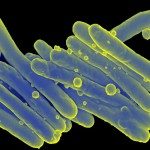Link to Pubmed [PMID] – 37450466
Link to DOI – 10.1371/journal.ppat.1011437
PLoS Pathog 2023 Jul; 19(7): e1011437
The molecular factors and genetic adaptations that contributed to the emergence of Mycobacterium tuberculosis (MTB) from an environmental Mycobacterium canettii-like ancestor, remain poorly investigated. In MTB, the PhoPR two-component regulatory system controls production and secretion of proteins and lipid virulence effectors. Here, we describe that several mutations, present in phoR of M. canettii relative to MTB, impact the expression of the PhoP regulon and the pathogenicity of the strains. First, we establish a molecular model of PhoR and show that some substitutions found in PhoR of M. canettii are likely to impact the structure and activity of this protein. Second, we show that STB-K, the most attenuated available M. canettii strain, displays lower expression of PhoP-induced genes than MTB. Third, we demonstrate that genetic swapping of the phoPR allele from STB-K with the ortholog from MTB H37Rv enhances expression of PhoP-controlled functions and the capacities of the recombinant strain to colonize human macrophages, the MTB target cells, as well as to cause disease in several mouse infection models. Fourth, we extended these observations to other M. canettii strains and confirm that PhoP-controlled functions are expressed at lower levels in most M. canettii strains than in M. tuberculosis. Our findings suggest that distinct PhoR variants have been selected during the evolution of tuberculosis bacilli, contributing to higher pathogenicity and persistence of MTB in the mammalian host.

